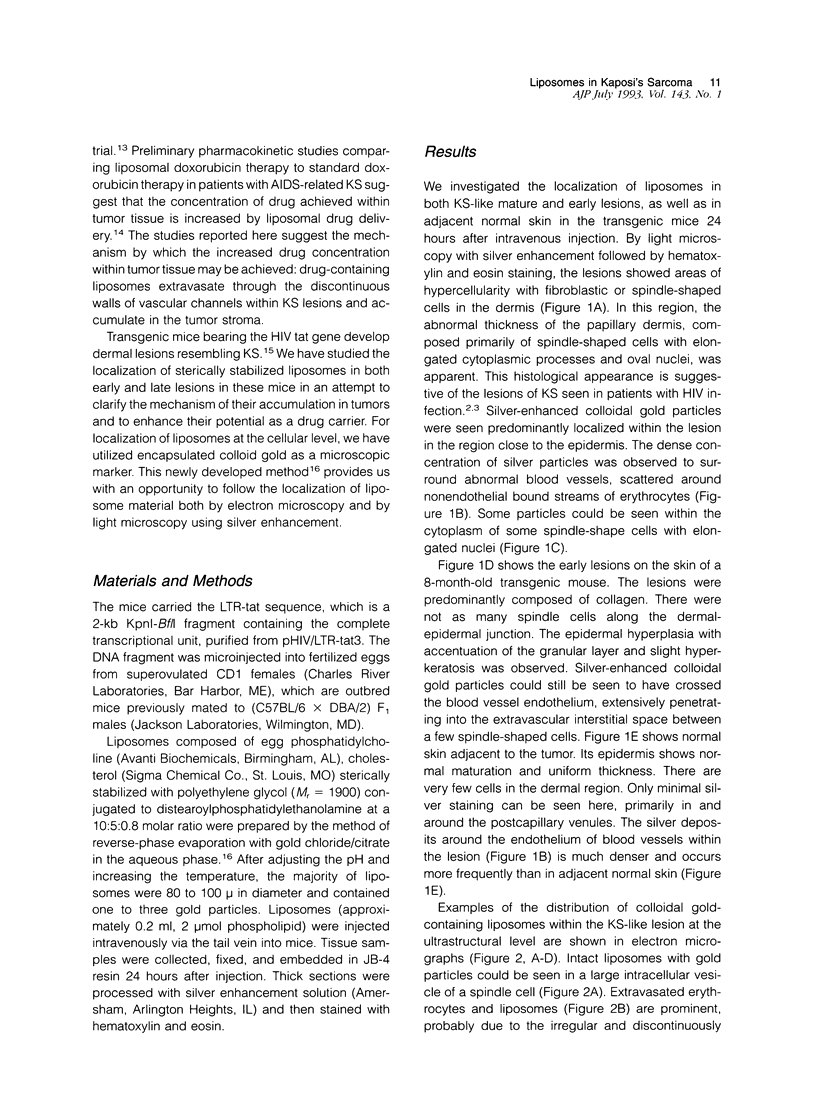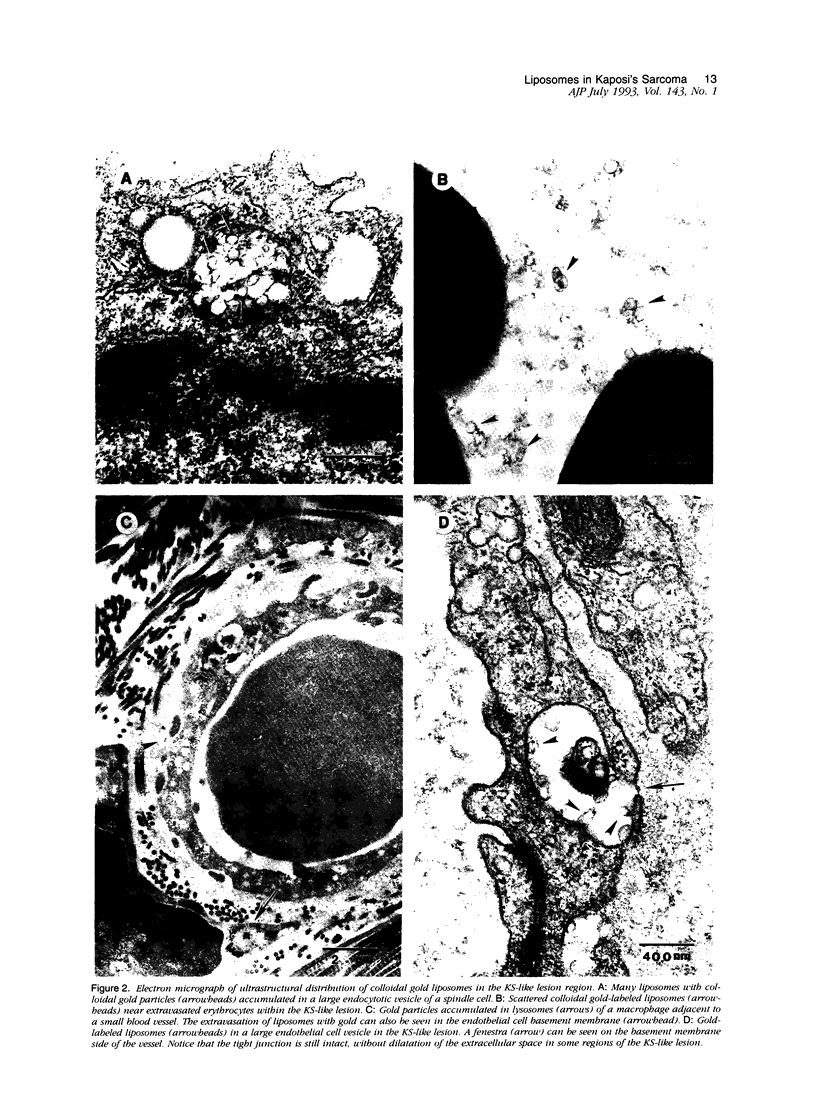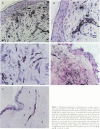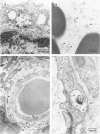Abstract
Transgenic mice bearing the HIV tat gene develop dermal lesions resembling a common malignant tumor in AIDS, Kaposi's sarcoma (KS). To evaluate the permeability characteristics of these lesions and the therapeutic potential of drug-carrying liposomes, we have studied the localization of sterically stabilized liposomes, which show long circulation time in blood and increased accumulation in tumors. Liposomes encapsulating colloidal gold were injected intravenously into transgenic mice bearing KS lesions, and tissues were processed 24 hours later for both electron microscopy and for light microscopy with silver enhancement. Liposomes and silver marker were detected predominantly in the dermis surrounding the early and mature KS lesions, which were characterized by a proliferation of fibroblast-like spindle cells and abnormal blood vessels close to the epidermis. The silver-enhanced gold marker often surrounded vascular channels and scattered erythrocytes. As determined by electron microscopy, some spindle cells and macrophages had ingested intact liposomes. Transendothelial transport of liposomes was observed both through open channels between endothelial cells and also through endothelial cells lining intact vessels. Both extravasation and transcytosis of liposomes through irregular endothelium were much higher in KS lesions than in the adjacent normal skin. The high accumulation of sterically stabilized liposomes in KS lesions and their intracellular uptake by some spindle cells enhances their potential as carriers of chemotherapeutic agents against this neoplasm.
Full text
PDF




Images in this article
Selected References
These references are in PubMed. This may not be the complete list of references from this article.
- Allen T. M., Chonn A. Large unilamellar liposomes with low uptake into the reticuloendothelial system. FEBS Lett. 1987 Oct 19;223(1):42–46. doi: 10.1016/0014-5793(87)80506-9. [DOI] [PubMed] [Google Scholar]
- Allen T. M., Hansen C., Martin F., Redemann C., Yau-Young A. Liposomes containing synthetic lipid derivatives of poly(ethylene glycol) show prolonged circulation half-lives in vivo. Biochim Biophys Acta. 1991 Jul 1;1066(1):29–36. doi: 10.1016/0005-2736(91)90246-5. [DOI] [PubMed] [Google Scholar]
- Armes J. A review of Kaposi's sarcoma. Adv Cancer Res. 1989;53:73–87. doi: 10.1016/s0065-230x(08)60279-1. [DOI] [PubMed] [Google Scholar]
- Francis N. D., Parkin J. M., Weber J., Boylston A. W. Kaposi's sarcoma in acquired immune deficiency syndrome (AIDS). J Clin Pathol. 1986 May;39(5):469–474. doi: 10.1136/jcp.39.5.469. [DOI] [PMC free article] [PubMed] [Google Scholar]
- Gabizon A. A. Selective tumor localization and improved therapeutic index of anthracyclines encapsulated in long-circulating liposomes. Cancer Res. 1992 Feb 15;52(4):891–896. [PubMed] [Google Scholar]
- Gabizon A., Papahadjopoulos D. Liposome formulations with prolonged circulation time in blood and enhanced uptake by tumors. Proc Natl Acad Sci U S A. 1988 Sep;85(18):6949–6953. doi: 10.1073/pnas.85.18.6949. [DOI] [PMC free article] [PubMed] [Google Scholar]
- Huang S. K., Lee K. D., Hong K., Friend D. S., Papahadjopoulos D. Microscopic localization of sterically stabilized liposomes in colon carcinoma-bearing mice. Cancer Res. 1992 Oct 1;52(19):5135–5143. [PubMed] [Google Scholar]
- Huang S. K., Mayhew E., Gilani S., Lasic D. D., Martin F. J., Papahadjopoulos D. Pharmacokinetics and therapeutics of sterically stabilized liposomes in mice bearing C-26 colon carcinoma. Cancer Res. 1992 Dec 15;52(24):6774–6781. [PubMed] [Google Scholar]
- Lasic D. D., Martin F. J., Gabizon A., Huang S. K., Papahadjopoulos D. Sterically stabilized liposomes: a hypothesis on the molecular origin of the extended circulation times. Biochim Biophys Acta. 1991 Nov 18;1070(1):187–192. doi: 10.1016/0005-2736(91)90162-2. [DOI] [PubMed] [Google Scholar]
- Mayhew E. G., Lasic D., Babbar S., Martin F. J. Pharmacokinetics and antitumor activity of epirubicin encapsulated in long-circulating liposomes incorporating a polyethylene glycol-derivatized phospholipid. Int J Cancer. 1992 May 8;51(2):302–309. doi: 10.1002/ijc.2910510221. [DOI] [PubMed] [Google Scholar]
- Papahadjopoulos D., Allen T. M., Gabizon A., Mayhew E., Matthay K., Huang S. K., Lee K. D., Woodle M. C., Lasic D. D., Redemann C. Sterically stabilized liposomes: improvements in pharmacokinetics and antitumor therapeutic efficacy. Proc Natl Acad Sci U S A. 1991 Dec 15;88(24):11460–11464. doi: 10.1073/pnas.88.24.11460. [DOI] [PMC free article] [PubMed] [Google Scholar]
- Vogel J., Hinrichs S. H., Reynolds R. K., Luciw P. A., Jay G. The HIV tat gene induces dermal lesions resembling Kaposi's sarcoma in transgenic mice. Nature. 1988 Oct 13;335(6191):606–611. doi: 10.1038/335606a0. [DOI] [PubMed] [Google Scholar]




